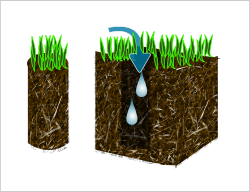AERATION
|
AERATION
Lawn aeration consists of perforating the soil with tiny holes to allow water, air, and nutrients to better penetrate the grass roots. Aeration helps by remedying soil compaction and promoting stronger, deeper root growth. The best time to aerate your lawn is during the growing season to give your lawn ample time to heal and fill back in after the removal of the soil plugs. Reasons to Aerate Your Lawn It’s easy to spot a lawn that has been aerated. Across the surface, you can easily spot small, uniform plugs of soil, usually exposing the various layers of soil below. There are numerous benefits of lawn aeration. Some of these key benefits include strengthening the roots of the grass, improving the effectiveness of lawn fertilization, and increasing the lawn’s ability to absorb heat. Lawn aeration is also effective at saving water, as it allows more water to be absorbed into the soil instead of running off the turf. Signs that a Lawn Needs Aeration Lawn aeration may be required if the soil is dry, if the grass is in poor condition due to insufficient nutrients in the soil, or if the soil is compacted. If your lawn gets a lot of use, the soil is likely compacted. Compaction is also likely if you park your vehicle on the grass, or if puddles of water collect on the grass. If you have clay soil in your yard, it will likely require regular aeration. If your lawn has ½-inch or more of thatch, air, water, and nutrients are not adequately reaching the roots. When to Start the Aeration Process When your turf should be aerated will primarily depend on the type of grass. Cool season turf, such as Kentucky bluegrass or ryegrass, should ideally be aerated in the late fall to allow time for recovery before the dormant season. Spring aerations can also be performed on cool season turf. Warm season turf, such as Bermuda or Buffalo grass, should be aerated during the summer. If the soil is severely impacted, it may be necessary to aerate the lawn before the peak growing time. Other Things to Consider It’s best to aerate your lawn when the soil is moist, as issues can occur if aeration is performed on soil that is too wet or too dry. If needed, water your lawn for one to two days prior to the aeration process. If your grass is thinning or has bare spots, you may want to consider seeding your lawn during aeration. Grass seed placed directly into the aeration holes can result in a green, plush, and attractive lawn. Weed Control Unsightly weeds can make it difficult to enjoy your lush, green lawn. To eliminate out of control weeds in your yard, trust out Knoxville Landscaping Company weed control specialists. Our expert lawn care services aim to eradicate weeds that can easily spread throughout your landscape, wreaking havoc in their path. To prevent the further spreading of unwanted plants in your yard, it’s important to act quickly and undergo prompt weed control measures. Main Types of Lawn Weeds In the United States, there are two primary types of weeds that grow on lawns, including grassy weeds and broadleaf weeds. Grassy weeds, such as crabgrass, are fairly resilient and can grow in the same conditions as regular grass. Broadleaf weeds, such as clover, dandelion, purslane, and chickweed, may contain flowers but are still weeds. As many types of weeds are durable and can thrive in grassy conditions, it’s vital to have a professional eliminate the weeds without harming the surrounding grass. Weed Control Treatment Options Our weed control specialists may use a range of treatment options to get rid of existing weeds and deter new weeds from growing. Your lawn care specialists will develop a custom plan that caters to your personal preferences and the unique needs of your lawn. Our pre-emergent weed control management method aims to prevent young seedlings from sprouting, while our post-emergent weed control method addresses most of the weeds that are currently growing in your yard. Perennial vs. Annual Lawn Weeds When it comes to weed control, not all treatment methods provide an adequate resolution. To effectively rid your yard of weeds, it’s important to first determine if the weeds are perennials or annuals. Annual weeds have a growing season of one year or less and are usually started when a seed is dropped on your lawn. Perennial weeds grow back multiple times and establish roots in your lawn. Getting rid of perennial weeds can be tough unless all the roots are removed entirely. Steps to Achieving a Weed-Free Yard Our lawn care services are exceptional. With assistance from our expert lawn care specialists, you can achieve a healthy, weed-free yard that is well-manicured and maintained. When you discover weeds in your yard, your first course of action may be to simply pull them from the ground. It’s important to realize that this is only a temporarily solution, and that the weeds will likely grow back, especially if parts of the roots remain in the ground. Control unwanted weeds in your yard or business landscape with pre and post-emergent treatments designed to kill existing weeds and prevent seedlings from thriving. When you contact our Knoxville Landscaping Company weed control crew, we’ll arrive to your home or business, assess the situation, and come up with the best course of action depending on your lawn’s unique needs and your budget. For more information about our Knoxville Landscaping Company lawn care services or weed control treatments, contact us today. Call Knoxville, TN. Landscaping Contractor Company For Any Landscaping or Grounds Maintenance Work |
|


